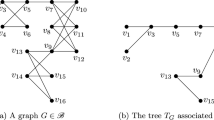Abstract
A square matrix V is called rigid if every matrix \({V^\prime}\) obtained by altering a small number of entries of V has sufficiently high rank. While random matrices are rigid with high probability, no explicit constructions of rigid matrices are known to date. Obtaining such explicit matrices would have major implications in computational complexity theory. One approach to establishing rigidity of a matrix V is to come up with a property that is satisfied by any collection of vectors arising from a low-dimensional space, but is not satisfied by the rows of V even after alterations. In this paper, we propose such a candidate property that has the potential of establishing rigidity of combinatorial design matrices over the field \({\mathbb{F}_2.}\)
Stated informally, we conjecture that under a suitable embedding of \({\mathbb{F}_2^n}\) into \({\mathbb{R}^n,}\) vectors arising from a low-dimensional \({\mathbb{F}_2}\)-linear space always have somewhat small Kolmogorov width, i.e., admit a non-trivial simultaneous approximation by a low-dimensional Euclidean space. This implies rigidity of combinatorial designs, as their rows do not admit such an approximation even after alterations. Our main technical contribution is a collection of results establishing weaker forms and special cases of the conjecture above.
Similar content being viewed by others
References
Michael Alekhnovich (2003). More on average case vs. approximation complexity. In 44th IEEE Symposium on Foundations of Computer Science (FOCS), 298–307.
Noga Alon & Gil Cohen (2013). On rigid matrices and U-polynomials. In 28th IEEE Computational Complexity Conference (CCC), 197–206.
Noga Alon, Rina Panigrahy & Sergey Yekhanin (2009). Deterministic approximation algorithms for the nearest codeword problem. In 13th International Workshop on Randomization and Computation (RANDOM), volume 5687 of Lecture Notes in Computer Science, 339–351.
Bai Zhidong, Silverstein Jack (2010) Spectral Analysis of Large Dimensional Random Matrices. Springer, New York
Dvir Zeev (2011) On matrix rigidity and locally self-correctable codes. Computational Complexity 20: 367–388
Friedman Joel (1993) A note on matrix rigidity. Combinatorica 13: 235–239
Hamada Noboru (1973) On the p-rank of the incidence matrix of a balanced or partially balanced incomplete block design and its applications to error-correcting codes. Hiroshima Mathematical Journal 3: 154–226
Ismagilov R. S. (1968) n-dimensional width of compact in Hilbert space. Journal of Functional Analysis and Applications 2: 32–39
Stasys Jukna (2001). Extremal combinatorics. Springer, Berlin, Heidelberg, New York.
Jungnickel Dieter, Tonchev Vladimir (2009) Polarities, quasi-symmetric designs, and Hamada conjecture. Designs, Codes, and Cryptography 51: 131–140
Kashin Boris, Razborov Alexander (1998) Improved lower bounds on the rigidity of Hadamard matrices. Mathematical Notes 63: 471–475
Lokam Satyanarayana (2001) Spectral methods for matrix rigidity with applications to size-depth trade-offs and communication complexity. Journal of Computer and System Sciences 63: 449–473
Lokam Satyanarayana (2009) Complexity lower bounds using linear algebra. Foundations and Trends in Theoretical Computer Science 4: 1–155
F. J. MacWilliams & N. J. A. Sloane (1977). The Theory of Error Correcting Codes. North Holland, Amsterdam, New York.
Ilan Newman & Yuri Rabinovich (2013). On multiplicative \({\lambda}\)-approximations and some geometric applications. SIAM Journal on Computing 42, 885–883.
Alexander Razborov (1989). On rigid matrices. Manuscript. In Russian.
Razborov Alexander, Rudich Steven (1997) Natural proofs. Journal of Computer and System Sciences 55: 24–35
Shubhangi Saraf & Sergey Yekhanin (2011). Noisy interpolation of sparse polynomials, and applications. In 26th IEEE Computational Complexity Conference (CCC), 86–92.
Rocco Servedio & Emanuele Viola (2012). On a special case of rigidity. In Electronic Colloquium on Computational Complexity (ECCC), TR12-144.
Shokrollahi Amin, Spielman Daniel, Stemann Volker (1997) A remark on matrix rigidity. Information Processing Letters 64: 283–285
Smith Kempton (1969) On the p-rank of the incidence matrix of points and hyperplanes in a finite projective geometry. Journal of Combinatorial Theory 7: 122–129
Temlyakov Vladimir (1998) Nonlinear Kolmogorov widths. Mathematical Notes 63: 785–795
Kirill Uskov (2002). Kolmogorov width of geometric configurations and functional compacts in Hilbert spaces. Ph.D. thesis, Moscow State Technical University. In Russian.
Leslie Valiant (1977). Graph-theoretic arguments in low level complexity. In 6th Symposium on Mathematical Foundations of Computer Science (MFCS), 162–176.
Author information
Authors and Affiliations
Corresponding author
Rights and permissions
About this article
Cite this article
Samorodnitsky, A., Shkredov, I. & Yekhanin, S. Kolmogorov Width of Discrete Linear Spaces: an Approach to Matrix Rigidity. comput. complex. 25, 309–348 (2016). https://doi.org/10.1007/s00037-016-0129-8
Received:
Published:
Issue Date:
DOI: https://doi.org/10.1007/s00037-016-0129-8




